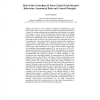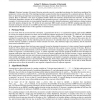41 search results - page 8 / 9 » Neural Pathways of Embodied Simulation |
NEUROSCIENCE
2001
Springer
13 years 9 months ago
2001
Springer
The Brain is a slow computer yet humans can skillfully play games such as tennis where very fast reactions are required. Of particular interest is the evidence for strategic thinki...
BIOSYSTEMS
2007
13 years 5 months ago
2007
10 Phonotaxis is the ability to orient towards or away from sound sources. Crickets can locate conspecifics by phonotaxis to the calling (mating) song they produce, and can evade ...
NIPS
2008
13 years 6 months ago
2008
Abstract: Structure learning of dynamic Bayesian networks provide a principled mechanism for identifying conditional dependencies in time-series data. This learning procedure assum...
CF
2010
ACM
13 years 8 months ago
2010
ACM
: The SpiNNaker machine is a massively parallel computing system, consisting of 1,000,000 cores. From one perspective, it has a place in Flynns' taxonomy: it is a straightforw...
ISCI
2000
13 years 4 months ago
2000
The branch of semiotics called semantics deals with the relation between meanings and representations, widely known as the symbol grounding problem. The other branches of semiotic...


